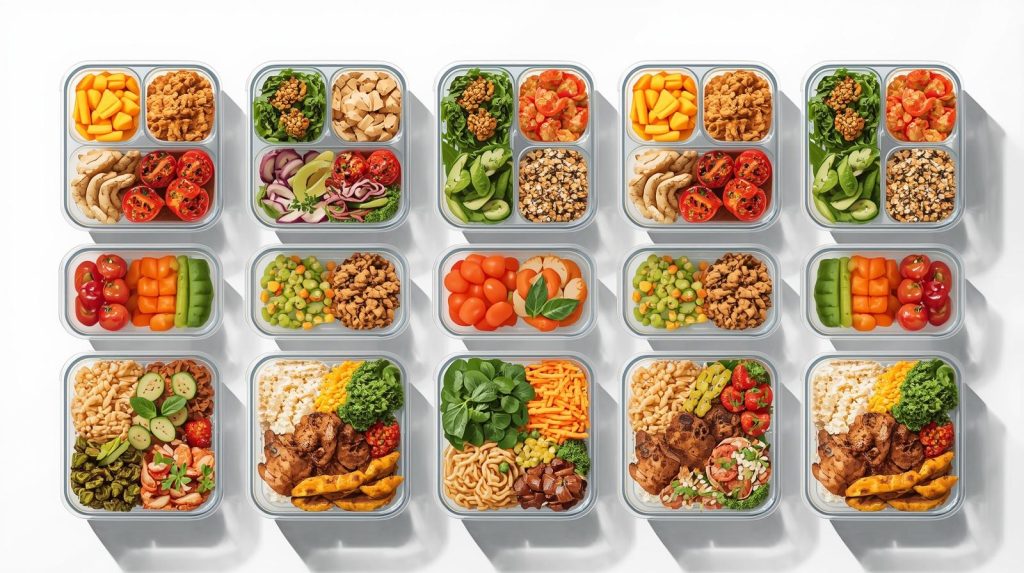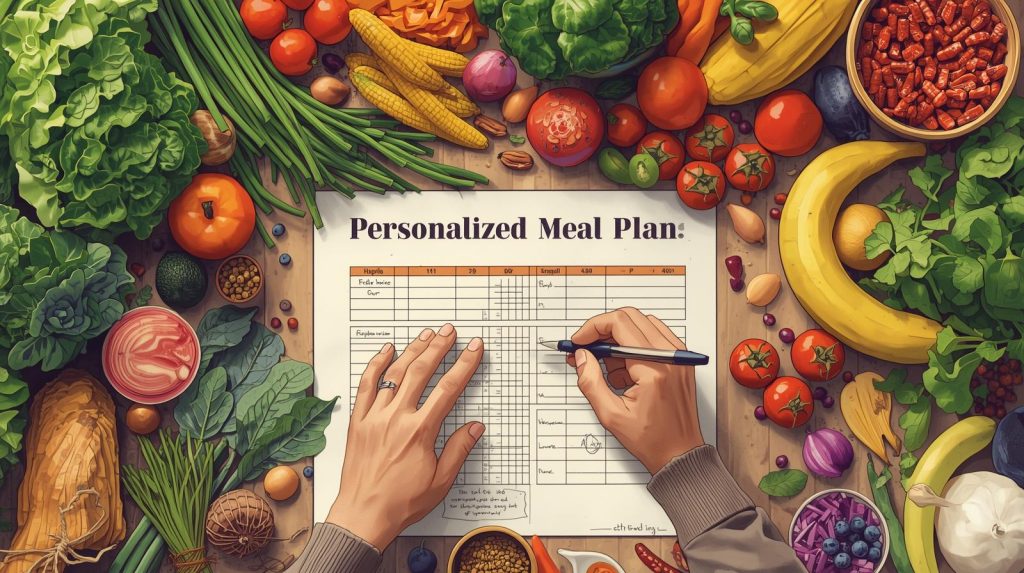Ultimate Personalized Meal Plans: 7 Guides Now
Embarking on a health journey can feel overwhelming, but the ultimate personalized meal plans offer a clear path to success. Unlike generic, one-size-fits-all diets, a plan tailored to you considers your unique health goals, dietary needs, lifestyle, and even your favorite foods.
This customized approach not only makes healthy eating more enjoyable but also far more sustainable in the long run.
By creating a roadmap for your nutrition, you can eliminate guesswork, reduce stress, and empower yourself to achieve your wellness aspirations, whether they involve weight loss, muscle gain, or managing a health condition.
This article provides seven essential guides to help you craft the perfect personalized meal plan from start to finish.thednadietitian+1
Why You Need the Ultimate Personalized Meal Plans for a Healthier Lifestyle
Adopting ultimate personalized meal plans is more than just deciding what to eat; it's a strategic approach to transforming your health, finances, and daily routine. By aligning your nutrition with your specific needs, you can unlock a range of benefits that generic diets cannot offer. thegutfeeling
Achieve Your Health Goals with Ultimate Personalized Meal Plans
A tailored diet plan is a powerful tool for reaching your specific wellness objectives. It provides a structured framework for tracking your progress, managing calorie intake, and ensuring a balanced diet rich in essential nutrients.
Whether your goal is weight loss, managing a chronic condition like diabetes, or improving your fitness, a personalized plan provides a clear and effective route to success.betterme+2
Save Time and Money with Ultimate Personalized Meal Plans
Effective meal planning is a game-changer for your schedule and your wallet. With a plan in hand, you can create efficient shopping lists, minimize food waste, and rely on batch cooking to keep healthy options readily available.
This preparation helps reduce impulsive buying and the temptation of expensive, unhealthy takeout meals, leading to significant savings over time. The time you save on daily meal decisions can be reinvested into activities you love.ultimatemealplans+3
Improve Your Eating Habits for Good
One of the most significant advantages of a personalized meal plan is its ability to foster lasting, healthy eating habits.
By consistently consuming nutritious, balanced meals, you can reduce stress, boost your energy levels, and avoid the dreaded mid-day slump.
A plan introduces you to a diverse range of nutrient-dense foods and exciting flavors, turning healthy eating from a chore into an enjoyable experience.berrystreet+1
Reduce Stress Around Mealtimes
The daily question of “what's for dinner?” can be a surprising source of stress and anxiety. A personalized meal plan eliminates this daily indecision.
By planning your meals and snacks, you take the guesswork out of eating, which saves time and reduces mental fatigue.
This organized approach ensures that you always have a satisfying and healthy meal ready to go, making your routine smoother and more predictable.seasonhealth+1

The Core 7 Guides to Creating Your Ultimate Personalized Meal Plans
Crafting your own personalized meal plan is an empowering process. These seven guides will walk you through each step, from defining your goals to prepping your meals, ensuring you build a plan that is both effective and sustainable.
Guide 1: Define Your “Why” – Setting Clear Goals for Your Ultimate Personalized Meal Plans
The first and most critical step in creating your ultimate personalized meal plan is to understand your unique needs and motivations. A plan without a clear purpose is like a ship without a rudder.nutriadmin+1
Identifying Your Primary Objective
Start by asking yourself what you want to achieve. Are you aiming for weight loss, muscle gain, better athletic performance, or managing a health condition like prediabetes or high blood pressure?
Your primary goal will be the guiding star for all subsequent decisions, from your calorie targets to your food choices.seasonhealth+2
Considering Your Lifestyle
An effective meal plan must fit seamlessly into your daily life. Consider your work schedule, activity level, social commitments, and cooking habits.
A strategy that requires complex recipes every night won't work for someone with a demanding job, just as a low-calorie plan may not be suitable for a highly active individual. Be honest about what is realistic for you.workweeklunch+1
Guide 2: The Nutritional Blueprint – Calculating Your Calorie and Macro Needs
Once you know your goals, the next step is to create a nutritional blueprint. This involves calculating your daily calorie and macronutrient (protein, carbohydrates, and fats) requirements to ensure your body gets the fuel it needs to thrive.nutriadmin+1
Understanding Basal Metabolic Rate (BMR)
Your BMR, or basal metabolic rate, is the number of calories your body needs to perform basic life-sustaining functions at rest.
You can estimate your BMR using formulas like the Mifflin-St. Jeor Equation, and then adjust it based on your activity level to determine your total daily calorie needs. Online calculators can significantly simplify this process. nutriadmin
Balancing Macronutrients
Macronutrients are the building blocks of your diet. The ideal ratio of protein, fats, and carbs varies depending on your goals.
For example, someone looking to build muscle may need more protein, while an endurance athlete might require more carbohydrates. A balanced approach is crucial for sustained energy and overall health. betterme
Guide 3: The Flavor Profile – Tailoring to Your Tastes and Dietary Restrictions
For a meal plan to be sustainable, you have to enjoy the food you're eating. This guide focuses on the “personal” aspect of your ultimate personalized meal plans, ensuring it's filled with foods you love while respecting any dietary limitations.nutriadmin+1
Listing Your Favorite Foods
Begin by making a list of healthy foods and recipes you genuinely enjoy. Building your plan around familiar favorites makes the transition to structured eating much smoother and more pleasant. nutriadmin
Navigating Allergies and Intolerances
It is crucial to account for any food allergies, intolerances (like lactose or gluten), or sensitivities. A personalized plan allows you to completely exclude problematic ingredients, protecting you from discomfort or severe allergic reactions.ultimatemealplans+2
Choosing a Dietary Style
You can build your plan around a specific dietary style that aligns with your preferences and health goals, such as the Mediterranean diet, the Keto diet, Paleo, or a plant-based approach like veganism or vegetarianism. These frameworks can provide a helpful structure for your food choices and diet.mayoclinic+1

Guide 4: The Master Plan – Structuring Your Weekly Meals
With your goals, nutritional targets, and food preferences established, it's time to build your weekly schedule. This is where your plan comes to life, detailing what you'll eat for each meal and snack.workweeklunch+1
Planning Meal by Meal
Map out your breakfasts, lunches, dinners, and snacks for the week. Be specific to avoid ambiguity. For example, instead of just “chicken salad,” write “grilled chicken salad with mixed greens, tomatoes, and balsamic vinaigrette.” .seasonhealth
Incorporating Variety
To prevent boredom and ensure you're getting a wide range of nutrients, rotate your meals and ingredients. Choose different food items from the main food groups—carbohydrates, protein, and fat—and cycle them throughout the week.berrystreet+1
Being Realistic About Your Schedule
Review your calendar before planning. If you have a dinner date or know you'll be working late, don't schedule a home-cooked meal for that night.
Leaving a few meals open for spontaneity can prevent you from feeling overly restricted and help you stick to your plan in the long term. workweeklunch
Guide 5: The Smart Shopper – Creating an Efficient Grocery List
A well-crafted meal plan is intrinsically linked to smart grocery shopping. An organized list based on your plan is your best defense against impulse buys and food waste.thegutfeeling+1
From Plan to List
Once your weekly meals are planned, create a detailed shopping list with all the necessary ingredients. Many meal planning apps can automatically generate this list for you, saving time and ensuring you don't forget anything. ultimatemealplans
Shopping Your Pantry First
Before heading to the store, take inventory of your pantry, fridge, and freezer. Checking what you already have prevents you from buying duplicates, which saves money and reduces food waste.myplate
Sticking to the List
A structured shopping list helps you stay focused in the grocery store. By buying only what you need for your planned meals, you minimize the purchase of unhealthy, processed foods and keep your budget in check. berrystreet

Guide 6: The Prep Phase – Mastering Meal Preparation for Success
Meal preparation, or””meal prep”” is the secret weapon for sticking to your personalized plan, especially on busy days. Taking time to prepare meals and ingredients in advance sets you up for a week of healthy eating. seasonhealth
Batch Cooking Staples
Cook large batches of versatile staples, such as quinoa, brown rice, grilled chicken, or roasted vegetables. These can be used as the base for various meals throughout the week, such as salads, bowls, or stir-fries .seasonhealth
Pre-chopping and Storing
Save time during the week by washing and chopping vegetables, portioning out snacks like nuts or yogurt, or making salad dressings ahead of time. Store them in airtight containers to maintain freshness.seasonhealth
Portioning for Grab-and-Go
Divide your batch-cooked meals into individual, grab-and-go containers. This is perfect for lunches at work or quick dinners on busy nights, making the healthy choice the easy choice. seasonhealth
Guide 7: Review and Refine – Adapting Your Plan for Long-Term Success
Your personalized meal plan is not set in stone; it's a dynamic tool that should evolve with you. Regularly reviewing and adjusting your plan is key to long-term success and sustainability. nutriadmin
Tracking Your Progress
Pay attention to how your body is responding to the plan. Evaluate your energy levels, hunger, and progress towards your goals. This feedback will help you identify what's working and what needs adjustment. nutriadmin
Listening to Your Body
Don't be afraid to make changes. If you're consistently hungry, consider adjusting your portion sizes or meal timing. If you're getting bored with certain foods, try swapping them out for new, healthier options. The goal is to create a plan that feels good for your body.berrystreet+1
Seeking Professional Guidance
If you're struggling to create a plan or have complex health needs, consider working with a registered dietitian. A professional can provide expert, personalized guidance to tailor a nutrition plan that perfectly fits your lifestyle and health goals, making it easier to stick to a routine that works for you.berrystreet+1
Frequently Asked Questions About Ultimate Personalized Meal Plans
Q1: What is the best way to start creating ultimate personalized meal plans?
The best way to start is by defining your primary health goal and understanding your current eating habits.
Begin by tracking your food intake for a few days to establish a baseline, then use the guides in this article to create a plan that aligns with your objective, whether it's weight loss, muscle gain, or improved overall health.thednadietitian+1
Q2: How can ultimate personalized meal plans help me lose weight?
Personalized meal plans facilitate weight loss by creating a calorie deficit in a structured and sustainable manner.
They help you manage portion sizes, prioritize nutrient-dense foods, and balance macronutrients to keep you full and satisfied, reducing the likelihood of overeating or choosing unhealthy snacks.nutriadmin+1
Q3: Can I create ultimate personalized meal plans on a budget?
Absolutely. In fact, meal planning is one of the best ways to save money on food. By planning meals around seasonal produce, buying in bulk, and using ingredients across multiple recipes, you can significantly reduce your grocery bill and minimize food waste.thednadietitian+1
Q4: What's the difference between a personalized meal plan and a generic diet?
A generic diet offers a one-size-fits-all solution, while a personalized meal plan is tailored to your specific needs, preferences, and lifestyle. This customization makes it more effective, enjoyable, and much easier to stick with in the long run.betterme+1
Q5: How do I calculate my calorie needs for a meal plan?
You can start by using an online BMR (Basal Metabolic Rate) calculator, which estimates your calorie needs based on your age, gender, height, and weight.
Then, factor in your daily activity level to determine your total daily energy expenditure. For specific goals, such as weight loss or muscle gain, you'll adjust this number accordingly. nutriadmin
Q6: Do I need an app for ultimate personalized meal plans?
While not strictly necessary, meal planning apps can be beneficial. They can assist with recipe discovery, automatically generate grocery lists, and help track your nutritional intake, simplifying the entire process.eatthismuch+2
Q7: How do I ensure I get enough variety in my meal plan?
To ensure variety, make a conscious effort to rotate different sources of protein, carbohydrates, and fats every week.
Experiment with new recipes, try different cuisines, and incorporate seasonal fruits and vegetables to keep your meals interesting and nutritionally diverse.nutriadmin+1
Q8: How often should I update my personalized meal plan? It's a good practice to review your meal plan every few weeks or whenever your goals, schedule, or preferences change. If you hit a weight loss plateau or get bored with your meals, it's time to adjust your plan to keep it fresh and compelling. nutriadmin
Q9: Can a personalized meal plan accommodate food allergies?
Yes, this is one of the key benefits of a personalized plan. You have complete control to exclude any ingredients that cause allergic reactions or intolerances, such as nuts, dairy, or gluten, ensuring your meals are safe and enjoyable.betterme+1
Q10: Should I work with a dietitian to create my meal plan?
While you can create a plan on your own, working with a registered dietitian is highly recommended, especially if you have specific health conditions, allergies, or performance goals.
A dietitian can provide expert guidance to ensure your plan is nutritionally complete, safe, and perfectly tailored to you.berrystreet+1
Conclusion
With ultimate personalized meal plans, you're empowered to achieve your health goals, save time, and enjoy delicious food tailored just for you. Start your journey today—use our seven guides to take control of your nutrition and achieve a happier, healthier life. For more expert tips and fresh ideas, explore our related posts on meal planning and prep.

